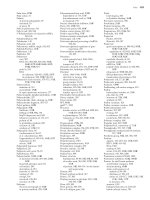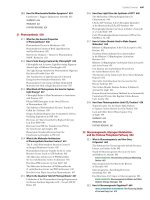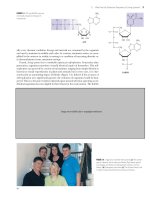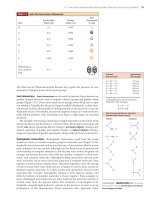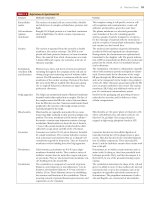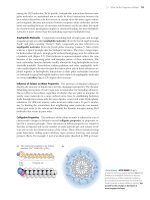Biochemistry, 4th Edition P13 pot
Bạn đang xem bản rút gọn của tài liệu. Xem và tải ngay bản đầy đủ của tài liệu tại đây (459.5 KB, 10 trang )
4.5 What Are the Spectroscopic Properties of Amino Acids? 83
Amino Acids Can Be Characterized by Nuclear Magnetic Resonance
The development in the 1950s of nuclear magnetic resonance (NMR), a spectro-
scopic technique that involves the absorption of radio frequency energy by certain
nuclei in the presence of a magnetic field, played an important part in the chemical
characterization of amino acids and proteins. Several important principles emerged
from these studies. First, the chemical shift
1
of amino acid protons depends on their
320300280260240220200
Wavelength (nm)
10
20
50
100
200
500
1,000
2,000
5,000
10,000
20,000
40,000
Molar absorptivity,
Phe
Tyr
Trp
FIGURE 4.10 The ultraviolet absorption spectra of the aromatic amino acids at pH 6. (From Wetlaufer, D. B., 1962.
Ultraviolet spectra of proteins and amino acids. Advances in Protein Chemistry 17:303–390.)
A DEEPER LOOK
The Murchison Meteorite—Discovery of Extraterrestrial Handedness
The predominance of L-amino acids in biological systems is one of
life’s intriguing features. Prebiotic syntheses of amino acids would
be expected to produce equal amounts of
L- and D-enantiomers.
Some kind of enantiomeric selection process must have intervened
to select
L-amino acids over their D-counterparts as the constituents
of proteins. Was it random chance that chose
L- over D-isomers?
Analysis of carbon compounds—even amino acids—from ex-
traterrestrial sources might provide deeper insights into this mys-
tery. John Cronin and Sandra Pizzarello have examined the enan-
tiomeric distribution of unusual amino acids obtained from the
Murchison meteorite, which struck the earth on September 28,
1969, near Murchison, Australia. (By selecting unusual amino
acids for their studies, Cronin and Pizzarello ensured that they
were examining materials that were native to the meteorite and
not earth-derived contaminants.) Four ␣-dialkyl amino acids—
␣-methylisoleucine, ␣-methylalloisoleucine, ␣-methylnorvaline,
and isovaline—were found to have an
L-enantiomeric excess of
2% to 9%.
This may be the first demonstration that a natural
L-enantiomer
enrichment occurs in certain cosmological environments. Could
these observations be relevant to the emergence of
L-enantiomers as
the dominant amino acids on the earth? And, if so, could there be
life elsewhere in the universe that is based upon the same amino
acid handedness?
CH C COOHCH
2
NH
3
+
CH
3
CH
3
CH
3
2-Amino-2,3-dimethylpentanoic acid
*
C COOHCH
2
NH
3
+
CH
3
CH
3
Isovaline
C COOHCH
2
NH
3
+
CH
3
CH
3
CH
2
␣-Methylnorvaline
ᮤ
Amino acids found in the Murchison
meteorite.
*The four stereoisomers of this amino acid include the
D- and L-forms of
␣-methylisoleucine and ␣-methylalloisoleucine.
Cronin, J. R., and Pizzarello, S., 1997. Enantiomeric excesses in meteoritic
amino acids. Science 275:951–955.
1
The chemical shift for any NMR signal is the difference in resonant frequency between the ob-
served signal and a suitable reference signal. If two nuclei are magnetically coupled, the NMR sig-
nals of these nuclei split, and the separation between such split signals, known as the coupling con-
stant, is likewise dependent on the structural relationship between the two nuclei.
84 Chapter 4 Amino Acids
particular chemical environment and thus on the state of ionization of the amino
acid. Second, the change in electron density during a titration is transmitted
throughout the carbon chain in the aliphatic amino acids and the aliphatic portions
of aromatic amino acids, as evidenced by changes in the chemical shifts of relevant
protons. Finally, the magnitude of the coupling constants between protons on adja-
cent carbons depends in some cases on the ionization state of the amino acid. This
apparently reflects differences in the preferred conformations in different ionization
states. Proton NMR spectra of two amino acids are shown in Figure 4.11. Because
CRITICAL DEVELOPMENTS IN BIOCHEMISTRY
Rules for Description of Chiral Centers in the (R,S) System
Naming a chiral center in the (R,S) system is accomplished by
viewing the molecule from the chiral center to the atom with the
lowest priority. If the other three atoms facing the viewer then de-
crease in priority in a clockwise direction, the center is said to
have the (R) configuration (where R is from the Latin rectus,
meaning “right”). If the three atoms in question decrease in pri-
ority in a counterclockwise fashion, the chiral center is of the (S)
configuration (where S is from the Latin sinistrus, meaning
“left”). If two of the atoms coordinated to a chiral center are iden-
tical, the atoms bound to these two are considered for priorities.
For such purposes, the priorities of certain functional groups
found in amino acids and related molecules are in the following
order:
SH Ͼ OH Ͼ NH
2
Ͼ COOH Ͼ CHO Ͼ CH
2
OH Ͼ CH
3
From this, it is clear that D-glyceraldehyde is (R)-glyceraldehyde
and
L-alanine is (S)-alanine (see figure). Interestingly, the ␣-carbon
configuration of all the
L-amino acids except for cysteine is (S). Cys-
teine, by virtue of its thiol group, is in fact (R)-cysteine.
L-Glyceraldehyde (S)-Glyceraldehyde
(R)-Glyceraldehyde
HO
C
H
CHO
CH
2
OH
D-Glyceraldehyde
H
C
OH
CHO
CH
2
OH
H
CH
2
OHOHC
OH
H
HOH
2
C CHO
OH
(S)-Alanine
H
–
OOC CH
3
NH
3
+
L-Alanine
H
3
N
C
H
COOH
CH
3
+
ᮡ
The assignment of (R) and (S) notation for glyceraldehyde and L-alanine.
Relative intensity
910 87654321 0
L-Alanine
Relative intensity
910 87654321 0
L-Tyrosine
ppm ppm
H
3
N
COOH
CH
CH
2
OH
+
H
3
N
COOH
CH
CH
3
+
FIGURE 4.11 Proton NMR spectra of several amino acids. Zero on the chemical shift scale is defined by the res-
onance of tetramethylsilane (TMS). (The large resonance at approximately 5 ppm is due to the normal HDO
impurity in the D
2
O solvent.) (Adapted from Aldrich Library of NMR Spectra.)
4.6 How Are Amino Acid Mixtures Separated and Analyzed? 85
they are highly sensitive to their environment, the chemical shifts of individual NMR
signals can detect the pH-dependent ionizations of amino acids. Figure 4.12 shows
the
13
C chemical shifts occurring in a titration of lysine. Note that the chemical shifts
of the carboxyl C, C
␣
, and C

carbons of lysine are sensitive to dissociation of the
nearby ␣-COOH and ␣-NH
3
ϩ
protons (with pK
a
values of about 2 and 9, respec-
tively), whereas the C
␦
and C
⑀
carbons are sensitive to dissociation of the ⑀-NH
3
ϩ
group. Such measurements have been very useful for studies of the ionization be-
havior of amino acid residues in proteins. More sophisticated NMR measurements at
very high magnetic fields are also used to determine the three-dimensional struc-
tures of peptides and proteins.
4.6 How Are Amino Acid Mixtures Separated and Analyzed?
Amino Acids Can Be Separated by Chromatography
A wide variety of methods is available for the separation and analysis of amino acids
(and other biological molecules and macromolecules). All of these methods take
advantage of the relative differences in the physical and chemical characteristics of
amino acids, particularly ionization behavior and solubility characteristics. Separa-
tions of amino acids are usually based on partition properties (the tendency to as-
sociate with one solvent or phase over another) and separations based on electrical
charge. In all of the partition methods discussed here, the molecules of interest are
allowed (or forced) to flow through a medium consisting of two phases—solid–
liquid, liquid–liquid, or gas–liquid. The molecules partition, or distribute them-
selves, between the two phases in a manner based on their particular properties and
their consequent preference for associating with one or the other phase.
In 1903, a separation technique based on repeated partitioning between phases
was developed by Mikhail Tswett for the separation of plant pigments (carotenes and
chlorophylls). Due to the colorful nature of the pigments thus separated, Tswett
called his technique chromatography. This term is now applied to a wide variety of
separation methods, regardless of whether the products are colored. The success of
all chromatography techniques depends on the repeated microscopic partitioning of
a solute mixture between the available phases. The more frequently this partitioning
can be made to occur within a given time span or over a given volume, the more ef-
ficient is the resulting separation. Chromatographic methods have advanced rapidly
in recent years, due in part to the development of sophisticated new solid-phase
materials. Methods important for amino acid separations include ion exchange
6
8
2
4
10
12
14
pH
4700 4500 4300 1400 1200 1000 800 600
Chemical shift in Hz (vs. TMS)
pK
3
pK
2
pK
1
Carboxyl
C
␣⑀␦␥
FIGURE 4.12 A plot of chemical shifts versus pH for the carbons of lysine.Changes in chemical shift are most
pronounced for atoms near the titrating groups.Note the correspondence between the pK
a
values and the par-
ticular chemical shift changes. All chemical shifts are defined relative to tetramethylsilane (TMS).
(From Suprenant,
H., et al.,1980. Carbon-13 NMR studies of amino acids:Chemical shifts, protonation shifts, microscopic protonation behavior. Jour-
nal of Magnetic Resonance 40:231–243.)
86 Chapter 4 Amino Acids
chromatography, gas chromatography (GC), and high-performance liquid chroma-
tography (HPLC).
A typical HPLC chromatogram using precolumn modification of amino acids to
form phenylthiohydantoin (PTH) derivatives is shown in Figure 4.13. HPLC is the
chromatographic technique of choice for most modern biochemists. The very high
resolution, excellent sensitivity, and high speed of this technique usually outweigh
the disadvantage of relatively low capacity.
4.7 What Is the Fundamental Structural Pattern in Proteins?
Chemically, proteins are unbranched polymers of amino acids linked head to tail,
from carboxyl group to amino group, through formation of covalent peptide
bonds, a type of amide linkage (Figure 4.14).
Peptide bond formation results in the release of H
2
O. The peptide “backbone”
of a protein consists of the repeated sequence ONOC
␣
OC
o
O, where the N repre-
Absorbance
Elution time
D
E
N
S
Q
G
R
A
Y
T
H
M
V
W
F
K
P
I
L
MO
2
CMC
FIGURE 4.13 Gradient separation of common PTH-amino acids, which absorb UV light. Absorbance was moni-
tored at 269 nm. PTH peaks are identified by single-letter notation for amino acid residues and by other abbre-
viations. D, Asp; CMC, carboxymethyl Cys; E, Glu; N, Asn; S, Ser; Q, Gln; H, His;T,Thr; G, Gly; R, Arg; MO
2
, Met sulfox-
ide; A, Ala;Y, Tyr; M, Met; V, Val; P, Pro;W, Trp; K, Lys; F, Phe; I, Ile; L, Leu. See Figure 4.8a for PTH derivatization. (Adapted
from Persson, B., and Eaker, D., 1990. An optimized procedure for the separation of amino acid phenylthiohydantoins by re-
versed phase HPLC. Journal of Biochemical and Biophysical Methods 21:341–350.)
CCH
O
O
–
H
3
N
O
N
R
1
C
Amino acid 1
+ CH
O
O
–
H
3
N
R
2
C
Amino acid 2
CHH
3
N
R
1
Dipeptide
O
O
–
C
H
CH
R
2
H
2
O
++ +
ANIMATED FIGURE 4.14 Peptide formation is the creation of an amide bond between the
carboxyl group of one amino acid and the amino group of another amino acid. See this figure animated at
www.cengage.com/login
4.7 What Is the Fundamental Structural Pattern in Proteins? 87
sents the amide nitrogen, the C
␣
is the ␣-carbon atom of an amino acid in the poly-
mer chain, and the final C
o
is the carbonyl carbon of the amino acid, which in turn
is linked to the amide N of the next amino acid down the line. The geometry of the
peptide backbone is shown in Figure 4.15. Note that the carbonyl oxygen and the
amide hydrogen are trans to each other in this figure. This conformation is favored
energetically because it results in less steric hindrance between nonbonded atoms
in neighboring amino acids. Because the ␣-carbon atom of the amino acid is a chi-
ral center (in all amino acids except glycine), the polypeptide chain is inherently
asymmetric. Only
L-amino acids are found in proteins.
The Peptide Bond Has Partial Double-Bond Character
The peptide linkage is usually portrayed by a single bond between the carbonyl car-
bon and the amide nitrogen (Figure 4.16a). Therefore, in principle, rotation may
occur about any covalent bond in the polypeptide backbone because all three
kinds of bonds (NOC
␣
, C
␣
OC
o
, and the C
o
ON peptide bond) are single bonds. In
this representation, the C
o
and N atoms of the peptide grouping are both in pla-
nar sp
2
hybridization and the C
o
and O atoms are linked by a bond, leaving the
nitrogen with a lone pair of electrons in a 2p orbital. However, another resonance
form for the peptide bond is feasible in which the C
o
and N atoms participate in a
bond, leaving a lone e
Ϫ
pair on the oxygen (Figure 4.16b). This structure pre-
vents free rotation about the C
o
ON peptide bond because it becomes a double
bond. The real nature of the peptide bond lies somewhere between these ex-
tremes; that is, it has partial double-bond character, as represented by the inter-
mediate form shown in Figure 4.16c.
Peptide bond resonance has several important consequences. First, it restricts
free rotation around the peptide bond and leaves the peptide backbone with only
two degrees of freedom per amino acid group: rotation around the NOC
␣
bond
and rotation around the C
␣
OC
o
bond.
1
Second, the six atoms composing the pep-
tide bond group tend to be coplanar, forming the so-called amide plane of the
polypeptide backbone (Figure 4.17). Third, the C
o
ON bond length is 0.133 nm,
which is shorter than normal CON bond lengths (for example, the C
␣
ON bond
R
R
0.123 nm
123.2°
0.133 nm
121.1°
115.6°
H
H
0.1 nm
121.9°
119.5°
N
0.145 nm
118.2°
0.152 nm
O
H
C
␣
C
C
␣
ANIMATED FIGURE 4.15 The peptide bond is shown in its usual trans conformation of car-
bonyl O and amide H.The C
␣
atoms are the ␣-carbons of two adjacent amino acids joined in peptide linkage.
The dimensions and angles are the average values observed by crystallographic analysis of amino acids and
small peptides.The peptide bond is the light-colored bond between C and N. (Adapted from Ramachandran, G. N.,
et al., 1974.The mean geometry of the peptide unit from crystal structure data. Biochimica et Biophysica Acta 359:298–302.)
See
this figure animated at www.cengage.com/login
1
The angle of rotation about the NOC
␣
bond is designated , phi, whereas the C
␣
OC
o
angle of ro-
tation is designated , psi.
88 Chapter 4 Amino Acids
(a)
NC
H
C
α
C
α
O
NC
H
C
α
O
C N
C
C
C
C
C
C
H
O
(b)
(c)
CN
H
–
O
+
CN
H
␦ –
O
+
A pure double bond between C
and O would permit free rotation
around the C N bond.
The other extreme would prohibit
C N bond rotation but would
place too great a charge on
O and N.
NC
HC
α
O
The true electron density is
intermediate. The barrier to
C N bond rotation of about
88 kJ/mol is enough to
keep the amide group planar.
C
α
C
α
␦
O
R
C
C
H
N
-carbon
H
C
R
H
-carbon
ACTIVE FIGURE 4.16 The partial double-bond character of the peptide bond. Resonance
interactions among the carbon, oxygen, and nitrogen atoms of the peptide group can be represented by two
resonance extremes (a and b). (a) The usual way the peptide atoms are drawn. (b) In an equally feasible form,
the peptide bond is now a double bond; the amide N bears a positive charge and the carbonyl O has a nega-
tive charge. (c) The actual peptide bond is best described as a resonance hybrid of the forms in (a) and (b).
Significantly, all of the atoms associated with the peptide group are coplanar, rotation about C
o
ON is
restricted, and the peptide is distinctly polar. (Illustration: Irving Geis. Rights owned by Howard Hughes Medical Institute.
Not to be reproduced without permission.)
Test yourself on the concepts in this figure at www.cengage
.com/login
FIGURE 4.17 The coplanar relationship of the atoms in
the amide group is highlighted as an imaginary shaded
plane lying between two successive ␣-carbon atoms in
the peptide backbone.
(Illustration: Irving Geis. Rights owned
by Howard Hughes Medical Institute. Not to be reproduced
without permission.)
4.7 What Is the Fundamental Structural Pattern in Proteins? 89
of 0.145 nm) but longer than typical CPN bonds (0.125 nm). The peptide bond
is estimated to have 40% double-bond character.
The Polypeptide Backbone Is Relatively Polar
Peptide bond resonance also causes the peptide backbone to be relatively polar. As
shown in Figure 4.16b, the amide nitrogen is in a protonated or positively charged
form, and the carbonyl oxygen is a negatively charged atom in this double-bonded
resonance state. In actuality, the hybrid state of the partially double-bonded peptide
arrangement gives a net positive charge of 0.28 on the amide N and an equivalent
net negative charge of 0.28 on the carbonyl O. The presence of these partial
charges means that the peptide bond has a permanent dipole. Nevertheless, the
peptide backbone is relatively unreactive chemically, and protons are gained or lost
by the peptide groups only at extreme pH conditions.
Peptides Can Be Classified According to How Many
Amino Acids They Contain
Peptide is the name assigned to short polymers of amino acids. Peptides are classi-
fied according to the number of amino acid units in the chain. Each unit is called an
amino acid residue, the word residue denoting what is left after the release of H
2
O
when an amino acid forms a peptide link upon joining the peptide chain. Dipeptides
have two amino acid residues, tripeptides have three, tetrapeptides four, and so on.
After about 12 residues, this terminology becomes cumbersome, so peptide chains
of more than 12 and less than about 20 amino acid residues are usually referred to
as oligopeptides, and when the chain exceeds several dozen amino acids in length,
the term polypeptide is used. The distinctions in this terminology are not precise.
Proteins Are Composed of One or More Polypeptide Chains
The terms polypeptide and protein are used interchangeably in discussing single
polypeptide chains. The term protein broadly defines molecules composed of one
or more polypeptide chains. Proteins with one polypeptide chain are monomeric
proteins. Proteins composed of more than one polypeptide chain are multimeric
proteins. Multimeric proteins may contain only one kind of polypeptide, in which
case they are homomultimeric, or they may be composed of several different kinds
of polypeptide chains, in which instance they are heteromultimeric. Greek letters
and subscripts are used to denote the polypeptide composition of multimeric pro-
teins. Thus, an ␣
2
-type protein is a dimer of identical polypeptide subunits, or a
homodimer. Hemoglobin (Table 4.2) consists of four polypeptides of two different
kinds; it is an ␣
2

2
heteromultimer.
Polypeptide chains of proteins typically range in length from about 100 amino
acids to around 2000, the number found in each of the two polypeptide chains of
myosin, the contractile protein of muscle. However, exceptions abound, including
human cardiac muscle titin, which has 26,926 amino acid residues and a molecular
weight of 2,993,497. The average molecular weight of polypeptide chains in eu-
karyotic cells is about 31,700, corresponding to about 270 amino acid residues.
Table 4.2 is a representative list of proteins according to size. The molecular weights
(M
r
) of proteins can be estimated by a number of physicochemical methods such as
polyacrylamide gel electrophoresis or ultracentrifugation (see Appendix to Chap-
ter 5). Precise determinations of protein molecular masses can be obtained by sim-
ple calculations based on knowledge of their amino acid sequence, which is often
available in genome databases. No simple generalizations correlate the size of pro-
teins with their functions. For instance, the same function may be fulfilled in dif-
ferent cells by proteins of different molecular weight. The Escherichia coli enzyme
responsible for glutamine synthesis (a protein known as glutamine synthetase) has a
molecular weight of 600,000, whereas the analogous enzyme in brain tissue has
a molecular weight of 380,000.
90 Chapter 4 Amino Acids
Protein M
r
Number of Residues per Chain Subunit Organization
Insulin (bovine) 5,733 21 (A) ␣
30 (B)
Cytochrome c (equine) 12,500 104 ␣
1
Ribonuclease A (bovine pancreas) 12,640 124 ␣
1
Lysozyme (egg white) 13,930 129 ␣
1
Myoglobin (horse) 16,980 153 ␣
1
Chymotrypsin (bovine pancreas) 22,600 13 (␣) ␣␥
132 ()
97 (␥)
Hemoglobin (human) 64,500 141 (␣) ␣
2

2
146 ()
Serum albumin (human) 68,500 550 ␣
1
Hexokinase (yeast) 96,000 200 ␣
4
␥-Globulin (horse) 149,900 214 (␣) ␣
2

2
446 ()
Glutamate dehydrogenase (liver) 332,694 500 ␣
6
Myosin (rabbit) 470,000 2,000 (heavy, h) h
2
␣
1
␣Ј
2

2
190 (␣)
149 (␣Ј)
160 ()
Ribulose bisphosphate carboxylase (spinach) 560,000 475 (␣) ␣
8

8
123 ()
Glutamine synthetase (E. coli) 600,000 468 ␣
12
*Illustrations of selected proteins listed in Table 4.2 are drawn to constant scale.
Adapted from Goodsell, D. S.,and Olson, A. J., 1993. Soluble proteins: Size, shape and function. Trends in Biochemical Sciences 18:65–68.
TABLE 4.2
Size of Protein Molecules*
Glutamine synthetase
Immunoglobulin
Hemoglobin
Insulin
Cytochrome c
Ribonuclease
Lysozyme
Myoglobin
SUMMARY
4.1 What Are the Structures and Properties of Amino Acids? The
central tetrahedral alpha (␣) carbon (C
␣
) atom of typical amino acids is
linked covalently to both the amino group and the carboxyl group. Also
bonded to this ␣-carbon are a hydrogen and a variable side chain. It is
the side chain, the so-called R group, that gives each amino acid its iden-
tity. In neutral solution (pH 7), the carboxyl group exists as OCOO
Ϫ
and the amino group as ONH
3
ϩ
. The amino and carboxyl groups of
amino acids can react in a head-to-tail fashion, eliminating a water mol-
ecule and forming a covalent amide linkage, which, in the case of pep-
tides and proteins, is typically referred to as a peptide bond. Amino
acids are also chiral molecules. With four different groups attached to
it, the ␣-carbon is said to be asymmetric. The two possible configura-
tions for the ␣-carbon constitute nonidentical mirror-image isomers or
enantiomers. The structures of the 20 common amino acids are
grouped into the following categories: (1) nonpolar or hydrophobic
amino acids, (2) neutral (uncharged) but polar amino acids, (3) acidic
amino acids (which have a net negative charge at pH 7.0), and (4) ba-
sic amino acids (which have a net positive charge at neutral pH).
4.2 What Are the Acid–Base Properties of Amino Acids? The com-
mon amino acids are all weak polyprotic acids. The ionizable groups are
not strongly dissociating ones, and the degree of dissociation thus de-
pends on the pH of the medium. All the amino acids contain at least two
dissociable hydrogens. The side chains of several of the amino acids also
contain dissociable groups. Thus, aspartic and glutamic acids contain an
additional carboxyl function, and lysine possesses an aliphatic amino
function. Histidine contains an ionizable imidazolium proton, and argi-
nine carries a guanidinium function.
4.3 What Reactions Do Amino Acids Undergo? The reactivities of
amino acids are essential to the degradation, sequencing, and chemical
synthesis of peptides and proteins. Reaction with phenylisthiocyanate
(Edman reagent) forms PTH derivatives of amino acids, which can be
easily identified and quantified.
4.4 What Are the Optical and Stereochemical Properties of Amino
Acids? Except for glycine, all of the amino acids isolated from proteins
are said to be asymmetric or chiral (from the Greek cheir, meaning
“hand”), and the two possible configurations for the ␣-carbon constitute
nonsuperimposable mirror-imag
e isomers, or enantiomers. Enantiomeric
molecules display a special property called optical activity—the ability to
rotate the plane of polarization of plane-polarized light. The magnitude
and direction of the optical rotation depend on the nature of the amino
acid side chain.
4.5 What Are the Spectroscopic Properties of Amino Acids? Many de-
tails of the structure and chemistry of the amino acids have been eluci-
dated or at least confirmed by spectroscopic measurements. None of
the amino acids absorbs light in the visible region of the electromag-
netic spectrum. Several of the amino acids, however, do absorb ultravi-
olet radiation, and all absorb in the infrared region. Proton NMR spec-
tra of amino acids are highly sensitive to their environment, and the
chemical shifts of individual NMR signals can detect the pH-dependent
ionizations of amino acids.
4.6 How Are Amino Acid Mixtures Separated and Analyzed? Separa-
tion can be achieved on the basis of the relative differences in the phys-
ical and chemical characteristics of amino acids, particularly ionization
behavior and solubility characteristics. The methods important for
amino acids include separations based on partition properties and sep-
arations based on electrical charge. HPLC is the chromatographic tech-
nique of choice for most modern biochemists. The very high resolution,
excellent sensitivity, and high speed of this technique usually outweigh
the disadvantage of relatively low capacity.
4.7 What Is the Fundamental Structural Pattern in Proteins? Proteins
are linear polymers joined by peptide bonds. The defining characteris-
tic of a protein is the amino acid sequence. The partial double-bonded
character of the peptide bond has profound influences on protein con-
formation. Proteins are also classified according to the length of their
polypeptide chains (how many amino acid residues they contain) and
the number and kinds of polypeptide chains.
Problems 91
PROBLEMS
Preparing for an exam? Create you own study path for this
chapter at www.cengage.com/login
1. Without consulting chapter figures, draw Fischer projection for-
mulas for glycine, aspartate, leucine, isoleucine, methionine, and
threonine.
2. Without reference to the text, give the one-letter and three-letter
abbreviations for asparagine, arginine, cysteine, lysine, proline, ty-
rosine, and tryptophan.
3. Write equations for the ionic dissociations of alanine, glutamate,
histidine, lysine, and phenylalanine.
4. How is the pK
a
of the ␣-NH
3
ϩ
group affected by the presence on an
amino acid of the ␣-COO
Ϫ
?
5. (Integrates with Chapter 2.) Draw an appropriate titration curve for
aspartic acid, labeling the axes and indicating the equivalence
points and the pK
a
values.
6. (Integrates with Chapter 2.) Calculate the concentrations of all
ionic species in a 0.25 M solution of histidine at pH 2, pH 6.4, and
pH 9.3.
7. (Integrates with Chapter 2.) Calculate the pH at which the ␥-carboxyl
group of glutamic acid is two-thirds dissociated.
8. (Integrates with Chapter 2.) Calculate the pH at which the ⑀-amino
group of lysine is 20% dissociated.
9. (Integrates with Chapter 2.) Calculate the pH of a 0.3 M solution of
(a) leucine hydrochloride, (b) sodium leucinate, and (c) isoelectric
leucine.
10. Absolute configurations of the amino acids are referenced to
D- and
L-glyceraldehyde on the basis of chemical transformations that can
convert the molecule of interest to either of these reference iso-
meric structures. In such reactions, the stereochemical conse-
quences for the asymmetric centers must be understood for each re-
action step. Propose a sequence of reactions that would demonstrate
that
L(Ϫ)-serine is stereochemically related to L(Ϫ)-glyceraldehyde.
11. Describe the stereochemical aspects of the structure of cystine, the
structure that is a disulfide-linked pair of cysteines.
12. Draw a simple mechanism for the reaction of a cysteine sulfhydryl
group with iodoacetamide.
13. A previously unknown protein has been isolated in your laboratory.
Others in your lab have determined that the protein sequence con-
tains 172 amino acids. They have also determined that this protein
has no tryptophan and no phenylalanine. You have been asked to
determine the possible tyrosine content of this protein. You know
from your study of this chapter that there is a relatively easy way to
do this. You prepare a pure 50 M solution of the protein, and you
place it in a sample cell with a 1-cm path length, and you measure
the absorbance of this sample at 280 nm in a UV-visible spectro-
92 Chapter 4 Amino Acids
photometer. The absorbance of the solution is 0.372. Are there ty-
rosines in this protein? How many? (Hint: You will need to use
Beer’s Law, which is described in any good general chemistry or
physical chemistry textbook. You will also find it useful to know that
the units of molar absorptivity are M
Ϫ1
cm
Ϫ1
.)
14. The simple average molecular weight of the 20 common amino
acids is 138, but most biochemists use 110 when estimating the num-
ber of amino acids in a protein of known molecular weight. Why do
you suppose this is? (Hint: there are two contributing factors to the
answer. One of them will be apparent from a brief consideration of
the amino acid compositions of common proteins. See for example
Figure 5.16 of this text.)
15. The artificial sweeteners Equal and Nutrasweet contain aspartame,
which has the structure:
What are the two amino acids that are components of aspartame?
What kind of bond links these amino acids? What do you suppose
CH OCH
3
C
OCH
2
H
3
NCH NHC
OCH
2
CO
2
–
As
p
artame
+
might happen if a solution of aspartame was heated for several hours
at a pH near neutrality? Suppose you wanted to make hot chocolate
sweetened only with aspartame, and you stored it in a thermos for
several hours before drinking it. What might it taste like?
16. Individuals with phenylketonuria must avoid dietary phenylalanine
because they are unable to convert phenylalanine to tyrosine. Look
up this condition and find out what happens if phenylalanine accu-
mulates in the body. Would you advise a person with phenylke-
tonuria to consume foods sweetened with aspartame? Why or
why not?
17. In this chapter, the concept of prochirality was discussed. Citrate
(see Figure 19.2) is a prochiral molecule. Describe the process by
which you would distinguish between the (RϪ) and (SϪ) portions
of this molecule and how an enzyme could discriminate between
similar but distinct moieties.
18. Amino acids are frequently used as buffers. Describe the pH range
of acceptable buffering behavior for the amino acids alanine, histi-
dine, aspartic acid, and lysine.
Preparing for the MCAT Exam
19. Although the other common amino acids are used as buffers, cys-
teine is rarely used for this purpose. Why?
20. Draw all the possible isomers of threonine and assign (R,S) nomen-
clature to each.
FURTHER READING
General Amino Acid Chemistry
Atkins, J. F., and Gesteland, R., 2002. The 22nd amino acid. Science
296:1409–1410.
Barker, R., 1971. Organic Chemistry of Biological Compounds, Chap. 4.
Englewood Cliffs, NJ: Prentice Hall.
Barrett, G. C., ed., 1985. Chemistry and Biochemistry of the Amino Acids.
New York: Chapman and Hall.
Greenstein, J. P., and Winitz M., 1961. Chemistry of the Amino Acids. New
York: John Wiley & Sons.
Herod, D. W., and Menzel, E. R., 1982. Laser detection of latent finger-
prints: Ninhydrin. Journal of Forensic Science 27:200–204.
Meister, A., 1965. Biochemistry of the Amino Acids, 2nd ed., Vol. 1. New
York: Academic Press.
Segel I. H., 1976. Biochemical Calculations, 2nd ed. New York: John Wiley
& Sons.
Srinivasan, G., James, C., and Krzycki, J., 2002. Pyrrolysine encoded by
UAG in Archaea: Charging of a UAG-decoding specialized tRNA.
Science 296:1459–1462.
Optical and Stereochemical Properties
Cahn, R. S., 1964. An introduction to the sequence rule. Journal of Chem-
ical Education 41:116–125.
Iizuke, E., and Yang, J. T., 1964. Optical rotatory dispersion of
L-amino
acids in acid solution. Biochemistry 3:1519–1524.
Kauffman, G. B., and Priebe, P. M., 1990. The Emil Fischer-William
Ramsey friendship. Journal of Chemical Education 67:93–101.
Suprenant, H. L., Sarneski, J. E., Key, R. R., Byrd, J. T., and Reilley, C. N.,
1980. Carbon-13 NMR studies of amino acids: Chemical shifts, pro-
tonation shifts, microscopic protonation behavior. Journal of Mag-
netic Resonance 40:231–243.
Separation Methods
Heiser, T., 1990. Amino acid chromatography: The “best” technique for
student labs. Journal of Chemical Education 67:964–966.
Mabbott, G., 1990. Qualitative amino acid analysis of small peptides by
GC/MS. Journal of Chemical Education 67:441–445.
Moore, S., Spackman, D., and Stein, W. H., 1958. Chromatography of
amino acids on sulfonated polystyrene resins. Analytical Chemistry
30:1185–1190.
NMR Spectroscopy
Bovey, F. A., and Tiers, G. V. D., 1959. Proton N.S.R. spectroscopy. V.
Studies of amino acids and peptides in trifluoroacetic acid. Journal
of the American Chemical Society 81:2870–2878.
de Groot, H. J., 2000. Solid-state NMR spectroscopy applied to mem-
brane proteins. Current Opinion in Structural Biology 10:593–600.
Hinds, M. G., and Norton, R. S., 1997. NMR spectroscopy of peptides
and proteins. Practical considerations. Molecular Biotechnology 7:
315–331.
James, T. L., Dötsch, V., and Schmitz, U., eds., 2001. Nuclear Magnetic Res-
onance of Biological Macromolecules. San Diego: Academic Press.
Krishna, N. R., and Berliner, L. J. eds. 2003. Protein NMR for the Millen-
nium. New York: Kluwer Academic/Plenum.
Opella, S. J., Nevzorov, A., Mesleb, M. F., and Marassi, F. M., 2002. Struc-
ture determination of membrane proteins by NMR spectroscopy.
Biochemistry and Cell Biology 80:597–604.
Roberts, G. C. K., and Jardetzky, O., 1970. Nuclear magnetic resonance
spectroscopy of amino acids, peptides and proteins. Advances in Pro-
tein Chemistry 24:447–545.
Amino Acid Analysis
Prata C., et al., 2001. Recent advances in amino acid analysis by capillary
electrophoresis. Electrophoresis 22:4129–4138.
Smith, A. J., 1997. Amino acid analysis. Methods in Enzymology 289:419–426.
